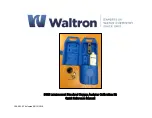
9
This prompt appears for 1 second each time the instrument is
turned on.
This indicates that the meter is in a ready state and zeroing can
be performed.
Sampling in Progress. This flashing prompt appears each time the
meter is performing a measurement.
This indicates that the meter is in a zeroed state and measurement
can be performed.
Light over range: the cuvet is not inserted correctly and an excess
ambient light is reaching the detector. If the cover is properly
installed, then contact your dealer or the nearest Hanna Customer
Service Center.
The blinking "BAT" indicates that the battery voltage is getting low
and the battery needs to be replaced.
This indicates that the battery is dead and must be replaced. Once
this indication is displayed, the meter will lock up. Change the
battery and restart.
“Configuration”: this indicates that the meter has lost its
configuration. Contact your dealer or the nearest Hanna Customer
Service Center.
CALIBRATION MODE MESSAGES
The date of the last calibration appears on the LCD each time the
calibration mode
is entered. If calibration is performed for the first
time, “F.CAL” appears.
This indicates that the factory calibration is selected.
GUIDE TO DISPLAY CODES
12
• It is important that the sample does not contain
any debris. This would corrupt the reading.
• In order to avoid reagent leaking and to obtain
more accurate measurements, it s recommended
to close the cuvet first with the supplied HDPE
plastic stopper and then with the black cap.
• Each time the cuvet is used, the cap must be
tightened to the same degree.
• Whenever the cuvet is placed into the measurement
cell, it must be dry outside, and completely free
of fingerprints, oil or dirt. Wipe it thoroughly with
HI 731318
(tissue for wiping cuvets, see chapter
ACCESSORIES) or a lint-free cloth prior to insertion.
• Do not let the reacted sample stand too long after
reagent is added, or accuracy will be lost.
• It is possible to take multiple readings in a row,
but it is recommended to take a new zero reading
for each sample and to use the same cuvet for
zeroing and measurement.
• After the reading it is important to discard
immediately the sample, otherwise the glass might
become permanently stained.
• All the reaction times reported in this manual are
referred to 20°C (68°F). As a general rule of
thumb, they should be doubled at 10°C (50°F)
and halved at 30°C (86°F).
• In order to maximize accuracy, prior to a
measurement follow the
validation procedure
to be sure that the instrument is properly
calibrated. If necessary, calibrate the instrument.




























